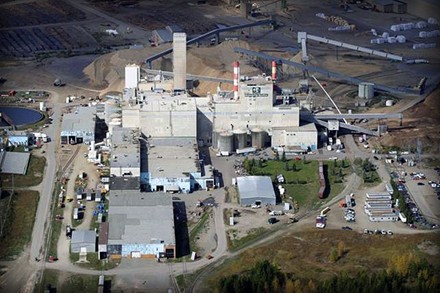Chlorine Dioxide Spill At Worthington-Mackenzie Mill
By 250 News
Sunday, February 22, 2009 10:58 AM
 Mackenzie, B.C.- There is no getting into the Worthington-Mackenzie pulp mill site in Mackenzie this morning. The industrial site is off limits to all but emergency personnel because of a chlorine dioxide leak. ( at right, aerial shot of Worthington-Mackenzie mill, scene of chlorine Dioxide spill, photo-opinion250 archive)
Mackenzie, B.C.- There is no getting into the Worthington-Mackenzie pulp mill site in Mackenzie this morning. The industrial site is off limits to all but emergency personnel because of a chlorine dioxide leak. ( at right, aerial shot of Worthington-Mackenzie mill, scene of chlorine Dioxide spill, photo-opinion250 archive)A valve on one of three chlorine tanks had first started weeping last week, and the valve was sealed in a fibreglass resin. The leak at that time was under the “reportable amount” but staff reported it anyway.
The encasement of the valve didn’t hold and the valve started leaking again last night. “We were advised of the leak at about 11 last night” says Minister of Forests and Range Pat Bell. “Ministry of Environment and Provincial Emergency Program personnel have been on the scene since about 3:00 this morning”.
Bell says the industrial site has been closed off as a precaution and an evacuation notice has been put in place. At this point there is no evacuation order in place. The townsite of Mackenzie is not in any immediate danger.
There are several steam plant operators on site, working to keep the mill warm enough, and steam plant operator Don Gervais says his crew is not in any immediate danger “I’ve told the Ministry of the Environment that if I thought there was any danger to my crew, they would be pulled out.” The Steam plant is equipped with special suits with breathing packs, in the event the leak worsens.
Minister Bell says the plan calls for the leaking tank to be emptied into one of two other chlorine dioxide tanks. If that is not possible, the contents will be mixed with white and black liquor and piped to the holding pond. “The pond has more than enough capacity to handle the contents of the tank” says Bell.
The tank and valves will then be inspected, and if repairable, repairs will be made. “I don’t want to minimize our concern, this is of a high concern to us, but at this point it is being managed.”
Just a few weeks ago, Canfor had a chlorine dioxide spill when one of the pipes between its P.G. Pulp and Intercon Pulp mills ruptured.
“This is a dangerous chemical” says Bell, “but it is being dealt with properly.”
Chlorine Dioxide and it's Health Impacts:
Chlorine dioxide is a highly endothermic compound that can decompose extremely violently when separated from diluting substances.
It is used to bleach pulp, bleach flour, treat municipal water in many cities, food processiong and is used in killing Legionella bacteria.
The following acute (short-term) health effects may occur immediately or shortly after exposure to chlorine dioxide:
- irritate the nose and throat, causing coughing and chest pain;
- eye irritation with watery eyes and seeing halos around lights;
- breathing chlorine dioxide can irritate the lungs causing coughing and/or shortness of breath.
Higher exposures can cause a build-up of fluid in the lungs (pulmonary oedema), a medical emergency but which might not occur for 24 hours, with severe shortness of breath and possibly death.
Chronic health effects : The following chronic (long-term) health effects can occur at some time after exposure to chlorine dioxide and can last for months or years:
- irritate the lungs;
- repeated exposure may cause bronchitis to develop with cough, phlegm, and/or shortness of breath.
- Permanent lung damage may occur, especially with repeated exposure to the vapours.
- There is limited evidence that chlorine dioxide may damage the developing foetus.
Previous Story - Next Story
Return to Home









It would only take 4 days to run this chemical thru the mill, making pulp, that could be stored or sold.
Then the chemical will have been dealt with the only known safe way. This is the key issue, what they want to do has not been done before, and at what price? What will we be killing in our environment?
Once the chemical has been transferred to the holding pond, is there a way to get it back into the mill?
Where does it go from there?
Still on evacuation alert in Mackenzie.